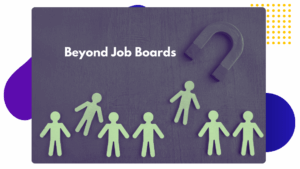In today’s current talent landscape, relying solely on traditional job boards to attract candidates is no longer a sufficient strategy. Employers must adopt a multi-channel approach to reach a wider audience, including “passive candidates”—those who are not actively searching for a new job but would be open to the right opportunity.
This report outlines actionable tips for employers to go beyond job boards and build a robust talent pipeline through diverse channels, complete with real-world examples.
1. Leverage Social Media for Recruitment and Branding
Social media is a powerful tool for recruitment, offering a platform to not only post job openings but also to build your employer brand and engage with potential candidates.
Actionable Tips & Examples:
- Establish a Strong Company Page:
- Example: Salesforce uses social media to promote its “Ohana” (Hawaiian for family) culture. Their Instagram and Twitter feeds are a mix of corporate updates and shared posts from employees, showcasing a vibrant and inclusive workplace. They also use the hashtag #SalesforceOhana to empower employees to act as brand ambassadors and share their experiences. This authentic content makes the company appear more human and relatable to potential hires.
- Utilize Targeted Advertising:
- Example: McDonald’s Canada ran a “Snaplications” campaign on Snapchat, where they targeted their ideal demographic—millennials and Gen Z—with a 30-second video resume application. This innovative approach met young job seekers on a platform they already use, making the application process fun, quick, and mobile-friendly.
- Encourage Employee Advocacy:
- Example: HubSpot has a popular Instagram account,
@hubspotlife, where different employees “take over” the account to share a day in their life. This gives job seekers an authentic, unfiltered look into the company culture from the perspective of someone actually working there, which can be far more convincing than a generic marketing video.
- Example: HubSpot has a popular Instagram account,
- Engage in Niche Communities:
- Example: Warby Parker, the trendy eyewear brand, used Snapchat’s “Desk Job” series to show what it was like to work in their offices. They also repurposed this content on other platforms. For tech companies, engaging in subreddits like
/r/programmingor/r/datasciencecan be a great way to find and connect with top engineering talent.
- Example: Warby Parker, the trendy eyewear brand, used Snapchat’s “Desk Job” series to show what it was like to work in their offices. They also repurposed this content on other platforms. For tech companies, engaging in subreddits like
2. Implement Strategic Email Campaigns
Email campaigns can be a highly effective way to nurture relationships with potential candidates over time, particularly for hard-to-fill roles or a talent pipeline. You’ve already paid to get candidates into your ATS, why not retarget them. You’ll need a good CRM to do this.
Actionable Tips & Examples:
- Build a Targeted Candidate List:
- A recruiter for a tech company might build a list of software engineers who previously applied for a role but weren’t a perfect fit at the time. They could then send a personalized email several months later when a new role opens that is a better match for that candidate’s specific skills, referencing their past application to show they were remembered.
- Personalize Your Outreach:
- Instead of a generic email, a recruiter could write something like: “Hi [Candidate Name], I saw your recent article on [topic] on Medium and was really impressed with your insights on [specific detail from article]. It made me think of our open role for a [Job Title] here at [Company Name]. Would you be open to a quick chat?” This demonstrates that you’ve done your homework and are genuinely interested in them as an individual, not just a resume.
- Create Email Sequences:
- A university recruiter could have a drip campaign for students they meet at career fairs. The first email might be a “nice to meet you” message, followed by a second email a week later that highlights the company’s internship program, and a third email with a video tour of the office. This keeps the company top-of-mind without being too aggressive.
3. Host and Participate in Recruitment Events
Recruitment events provide a valuable opportunity to interact with candidates in a less formal setting, allowing them to experience your company culture firsthand. Consider virtual job fairs a well.
Actionable Tips & Examples:
- Host an Open House or Meetup:
- Example: Cisco hosts “Career Meetups” where they invite job seekers to their offices to meet with hiring managers and engineers. This low-pressure environment allows candidates to ask questions, learn about the company’s projects, and network with employees, which can be a more personal and effective way to recruit than a standard interview.
- Sponsor or Participate in Industry Conferences:
- Example: A financial services firm might sponsor a booth at a FinTech conference. Their recruiters and senior employees can speak on panels and give presentations, positioning the company as an industry leader. This naturally attracts passive candidates who are interested in the latest trends and innovations.
- Engage with Educational Institutions:
- Example: A major accounting firm partners with universities to host on-campus workshops on topics like “Intro to Tax Law” or “Building a Financial Model.” This not only helps them identify top students but also builds a strong brand presence and positions them as a resource for future talent.
4. Utilize Targeted Digital Advertising and SEO
Beyond social media, a smart digital advertising strategy can drive qualified traffic to your careers page and increase your company’s visibility to potential candidates.
Actionable Tips & Examples:
- Optimize Your Careers Page for SEO:
- Example: A logistics company might optimize its careers page for long-tail keywords like “truck driver jobs with tuition reimbursement” or “warehouse manager positions in Dallas, TX.” This ensures that when a candidate is searching for a specific role and benefit, the company’s page is one of the first results they see.
- Run Pay-Per-Click (PPC) Campaigns:
- Example: A tech startup could use Google Ads to run a campaign targeting people searching for their competitors’ names plus the word “careers.” This is a bold move that captures the attention of passive candidates who might be exploring their options at other companies.
- Create Engaging Video Content:
- Example: Zappos uses its YouTube channel to showcase its vibrant company culture. Their videos often feature employees sharing their unique stories and experiences, giving candidates a genuine look at what it’s like to be a “Zapponian.”
5. Prioritize Your Employer Brand and Employee Referrals
Your employer brand is what potential candidates think and feel about your company as a place to work. A strong brand is a magnet for top talent.
Actionable Tips & Examples:
- Build a Culture Worth Promoting:
- Example: Netflix is famous for its unique culture deck, which outlines its core values of freedom and responsibility. This transparency and commitment to a high-performance culture not only attracts but also retains the best talent, as candidates know exactly what is expected and what they can expect in return.
- Launch a Strong Employee Referral Program:
- Example: Dell launched a successful employee referral program that included a significant financial bonus for successful hires. They promoted the program internally with a clear communication plan, which resulted in a large number of high-quality hires. Employees are more likely to refer a great candidate if they are well-compensated for it.
- Showcase Employee Experiences:
- Example: Marriott International has a strong social media presence focused on its employees. Their channels frequently feature stories of associates from different departments and countries, highlighting career growth opportunities and the company’s diverse workforce. Their message, “Be You,” is consistently reinforced with these real-life examples, making the brand feel inclusive and authentic.
A comprehensive talent attraction strategy is essential for modern employers to succeed. Instead of relying solely on job boards, organizations should adopt a multi-channel approach that incorporates social media, strategic email campaigns, recruitment events, and targeted digital advertising. By using platforms like LinkedIn and Instagram to showcase company culture and run targeted ads, companies can reach both active and passive candidates.
Implementing personalized email campaigns, hosting career events, and optimizing your careers page for SEO further broadens your reach. Finally, strengthening your employer brand and establishing a robust employee referral program transforms your current workforce into your most effective recruiters. By embracing these diverse, proactive methods, you can build a strong talent pipeline and attract top-tier candidates who might not otherwise be looking.



